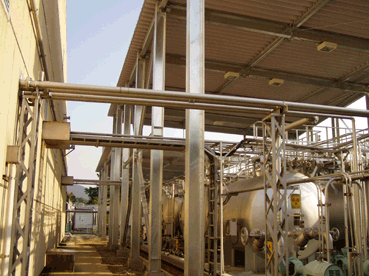Radioactive Waste Management Facility
Radioactive waste management facility consists of several waste treatment plants, storage tanks, a waste repository, analytical instruments for examining chemical properties and measuring radioactivity, etc.
Radioactive solid wastes are assorted by their properties (combustible, incombustible etc.), and then packaged in drums predetermined for each property. These drums are stored in a repository with other wastes such as high level liquid wastes, concentrate by evaporation, dehydrated sludge by chemical coagulation etc. Parts of these wastes in a repository are transferred about once a year to the waste dealer granted legal license for radioactive waste management.
High level liquid wastes (greater than 3.7×104Bq/cm³) are temporarily stored for cooling till they can be handled, then stored in a repository without any condensing operation. Other radioactive liquid wastes (medium and low level) are treated adequately to their radioactivity and physicochemical properties as follows.
- 1) Evaporation
- Medium level liquid wastes (0.37-3.7×104Bq/cm³) and/or liquid wastes with high salt content are treated by an evaporator that separates evaporated steam from remaining concentrate, which contains most of radioactivity in the waste. Entraining droplets are removed from steam stream by three particle separators; cyclone, packed column and perforated plate column. Concentrate by evaporation is accommodated in containers, and purified liquid is introduced to monitoring tanks. The treating capacity of the evaporation plant is 0.5m³/h.
- 2) Chemical coagulation and Freezing-and-thawing
- Low level radioactive liquid wastes (below 0.37 Bq/cm³) are treated by two series of chemical coagulation plants, which consist of chemical tanks, rapid mixing tanks, flocculator-sedimentators, anthracite filters etc. In this treatment process, radioactive materials are removed from liquid waste into sediment slurry by chemical coagulation followed by precipitation. This coagulator has the treating capacity of 5m³/h for one series. Sediment slurry is dehydrated by two freezing-thawing plants, whose treating capacity is 0.2m³/d for one series. Dehydrated slurry is accommodated in containers. Decontaminated effluent from the coagulator is filtered by anthracite, and purified liquid is introduced to monitoring tanks.
- 3) Ion exchange
- Two series of ion exchange plants are used for low salt content liquid waste, or they are utilized also for further treatment of liquid wastes already treated by the evaporator or the coagulator, if necessary. One ion exchange plant consists of a cation exchange column, an anion exchange column, a mixed column and an inorganic resin column. The inorganic resin column is particularly capable of cesium removal. Liquid waste is treated by proper combination of columns considering nuclides in liquid waste. The ion exchange plant has the treating capacity of 5 m³/h. Liquid waste is purified by adsorbing ionic radionuclides onto functional groups of ion exchange resin, and purified liquid is introduced to monitoring tanks.
Treated liquids are stored in monitoring tanks, and then released into the environment after confirmation that concentrations of radionuclides in the liquid are below the legal permissible limits.

Waste Treatment Facility




